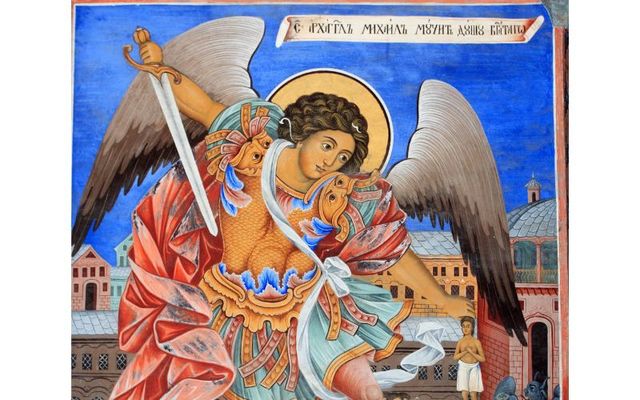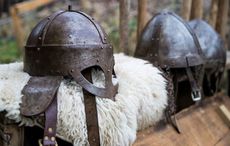The traditional harvest, the Autumn Equinox, religion, ancient history and cooking the fatted goose and a crumble in Ireland on Michaelmas.
Pop quiz: what’s the most popular Irish boy’s name? Odds are, the first one that came to mind was Patrick. Wrong. While Saint Patrick is Ireland’s patron, his name comes in at #18. Go ahead, try again. Did you say Sean? If so, you picked #2, and you get extra credit because Sean is also spelled Shane, Shawn, Shuan, Eoin, Ion, and Ian, all of which rank in the top twenty and honor the gospel writer John. Another Irish version of this venerable Hebrew name, which means “one whom God has favored,” is Jack, which places at #3.
Since you still haven’t picked the winner, I’ll save you some brain strain. The numero uno Irish boy’s name is Conor, a variant of Conaire Mor who, according to Irish legend and historical tradition, was Ireland’s most famous High King. His reign was long (ranging from thirty to seventy years depending on which account is consulted) and peaceful, quite a feat in a time when provincial kings contested constantly for supremacy. Conor’s birth, rise to power, and death are told in the Old Irish saga Togail Bruidne Dá Derga (The Destruction of Da Derga’s Hostel). A Middle Irish collection of poems and prose, compiled in the 11th century by an anonymous scholar and entitled Leabhar Gabhála na hÉireann (The Book of Invasions), dates his reign contemporary with the Roman emperor Augustus (27 BC-14 AD).
For sheer longevity and Gaelic authenticity, Conor takes the prize as the other top ten Irish boys’ names (James, Adam, Aaron, Michael, David, and Daniel) have their roots in the Christian tradition, which did not influence Ireland until its introduction by Saint Patrick in the 6th century AD. All but one of these popular names refer to wise and honorable men, but despite their wisdom they were merely human.
The singular exception is Michael the Archangel. Without too much stretching of the imagination, one could call him the Superman of Hebrew, Christian and Islamic traditions. When Lucifer challenged his divine Maker and led a rebellion among the legion of angels, it was Michael whom God called on to save not only the day, but all of creation as well. When Moses needed counsel and Isaac needed someone to save him from being sacrificed by his father, Michael came to their rescue. The Old Testament’s Book of Enoch states that Michael and his fellow archangels always accompanied Yaweh whenever he left his celestial throne. Think of them as a divine Secret Service detail and Michael as God’s finest field general.
In art, Michael is depicted as a majestic winged warrior, clad in full battle armor or chain mail with helmet, shield, and an unsheathed drawn sword. Sometimes he is shown standing above a dragon (symbolic of evil) that he has stabbed with a lance. At other times, he is pictured holding a pair of scales with which he weighs the souls of the dead before escorting them to their heavenly reward or banishing them to Hell.

Love Irish history? Share your favorite stories with other history buffs in the IrishCentral History Facebook group.
During the time of the Crusades, Michael was naturally named the patron of knights who fought to reclaim the Holy Land. Today, his patronage extends to all armed combatants – soldiers, mariners, and airborne units, especially fighter pilots and paratroopers – as well as civilian police officers, paramedics, EMTs, and other emergency responders. Shrines to Saint Michael are usually found in high places, frequently on mountaintops. A notable exception is Ireland’s Skellig Michael (Michael’s Rock), a craggy island in the Atlantic Ocean approximately 9 miles west of County Kerry.
Since the sixth century, the feast of Saint Michael the Archangel has been celebrated on September 29th. Known as The Feast of Michael and All Angels, or Michaelmas, it was a holy day of obligation, and everyone was required to attend mass. In Old Irish tradition, the day was called Fomhar na nGeanna, the Goose Harvest. Just like cows, geese born in the spring were put out to pasture in flocks to feed on grass. Called ‘green geese,’ they were a delicacy only enjoyed by the very wealthy as were their huge goose eggs, which were served at royal banquets on dishes of gold and silver.
Most geese, however, were kept until after summer’s grain harvest when they were released into the cut fields. Feeding on the fallen grain, these ‘stubble geese’ fattened up quickly. Believing that “If you eat goose at Michaelmas you will never want all year round,” people usually celebrated the saint’s day with a goose feast. Prized goose feathers and down were collected for filling mattresses and pillows.
In the southeast corner of Ireland, an old saying: La Fheile Mhichil a chroitear an t-ullord (On Michael’s Day the orchard is shaken) marks the beginning of the annual apple harvest. At almost the same time, the potato harvest comes in, and by Michaelmas, both crops are in abundant delicious supply. Saint Michael’s feast also signals an end to Ireland’s blackberry season, for it is told that when Michael tossed Satan out of heaven the Evil One landed in a blackberry bramble patch and was so annoyed at the many pricks he endured that each year on Michaelmas he returns to curse and spit on all blackberries, rendering them inedible.
In addition to its significance as Michael’s Feast, September 29th also marks one of the ‘quarter-days’ on the old Irish calendar. These four dates during the year, corresponded to religious festivals (12/25/Christmas, 3/25/Lady Day/The Annunciation, 6/24/Midsummer/St. John, 9/29/Michaelmas). Magistrates visited outlying towns to adjudicate legal cases, servants were hired, and rents were due, expanding Michael’s patronage to the legal and business professions. Frequently outstanding accounts were settled with payment of a Michaelmas goose.
Since September 29th arrives on the heels of the Autumnal Equinox, it also heralds the shortening of days when light from the sun begins to dim and the work of illuminating manuscripts such as The Book of Kells and in later years the setting of type had to be done by candlelight. Irish printers marked this changing of the year by treating their staff to a Michaelmas roast goose feast.
In view of Michael the Archangel’s many patronages, not the least of which is protection against temptation itself, it is not surprising that his name ranks in the top tier of popularity for Irish boys. Personally, I am most fond of Michael’s tie to publishing the written word, one of Ireland’s most lauded talents. For me, at least, it implies “The pen is mightier than the sword.” Think about it. Sláinte!
Recipes
Michaelmas roast goose with potato-apple stuffing recipe
From "Festive Food of Ireland" by Darina Allen.
Ingredients:
Goose:
- 1 10-pound goose (with giblets – neck, heart and gizzard)
- 1 onion
- 1 carrot
- Bouquet garni (1 sprig thyme, 3-4 parsley sprigs, 1 piece celery)
- 6-7 peppercorns.
Stuffing:
- 2 pounds potatoes
- 1⁄2 stick butter
- 1 pound chopped onions
- 1 pound Granny Smith apples, peeled & chopped
- 1-11⁄2 tablespoons chopped parsley
- 1-11⁄2 tablespoons lemon balm (optional)
- Salt and freshly ground black pepper.
Method:
Stuffing
Boil the unpeeled potatoes in salted water until cooked, peel and mash. Melt the butter and sweat the onions in a covered pan on medium heat for 5 minutes. Add the apples and cook until they break down, then stir in the mashed potatoes and herbs. Season with salt and pepper. Chill until cold before stuffing the goose.
Goose
Remove the wishbone for ease of carving. Put the goose into a saucepan with the giblets, onion, carrot, bouquet garni and peppercorns. Cover with cold water, bring to a boil and simmer for about 2 hours. Remove the bird carefully from the stock and pat dry. Season the cavity with salt and pepper and fill with the cold stuffing. Sprinkle some sea salt over the breast and rub into the skin. Roast for 2-2 1/2 hours in a preheated 350°F oven. Pour off the excess fat three or four times during the cooking (store this fat in your refrigerator as it keeps for months and is wonderful for roasting or sautéing potatoes). To test whether the goose is cooked, prick the thigh at the thickest part. The juices that run out should be clear; if they are pink, the goose needs a little longer roasting. When cooked, remove the goose to a large heatproof platter and put it into a low oven (200°F) while you make the gravy.
Gravy
Pour or spoon off the remainder of the fat. Add about 2 1/2 cups of strained giblet stock to the roasting pan, bring it to a boil and, using a small whisk, scrape the pan to dissolve the meaty brown bits. Taste for seasoning and if the gravy is weak, boil for a few minutes to concentrate the flavor, if too strong add a little stock. Strain into a gravy boat.
Before serving the goose, remove the stuffing to a medium bowl. Bring the goose to the table, carve it, and serve stuffing, applesauce, and gravy separately. An 8-10 pound goose will serve 8-10 people.
Blackberry apple crumble recipe
From "Good Food From Ireland" by Georgina Campbell.
Serves: 6 to 8
Ingredients:
- 2 pounds Granny Smith apples
- 1 pound blackberries
- 2 tablespoons water
- 6 ounces sugar
- 4 ounces cold butter
- 4 ounces whole wheat flour
- 2 ounces oatmeal flakes
- 2 ounces brown sugar
Method:
Peel, core and slice the apples. Mix with the blackberries. Add sugar and water to fruit and stir to combine. Place fruit in a 1 quart baking dish.
Crumble: Cut butter into flour, add oat flakes and brown sugar and continue cutting together until mixture becomes crumbly. Sprinkle over fruit, packing down lightly. Bake in a preheated 400°F oven for 15 minutes. Reduce heat to 375°F and continue baking for another 15-20 minutes until topping is crunchy brown and fruit has released its juices. Serve hot with cream, whipped cream or ice cream.




Comments